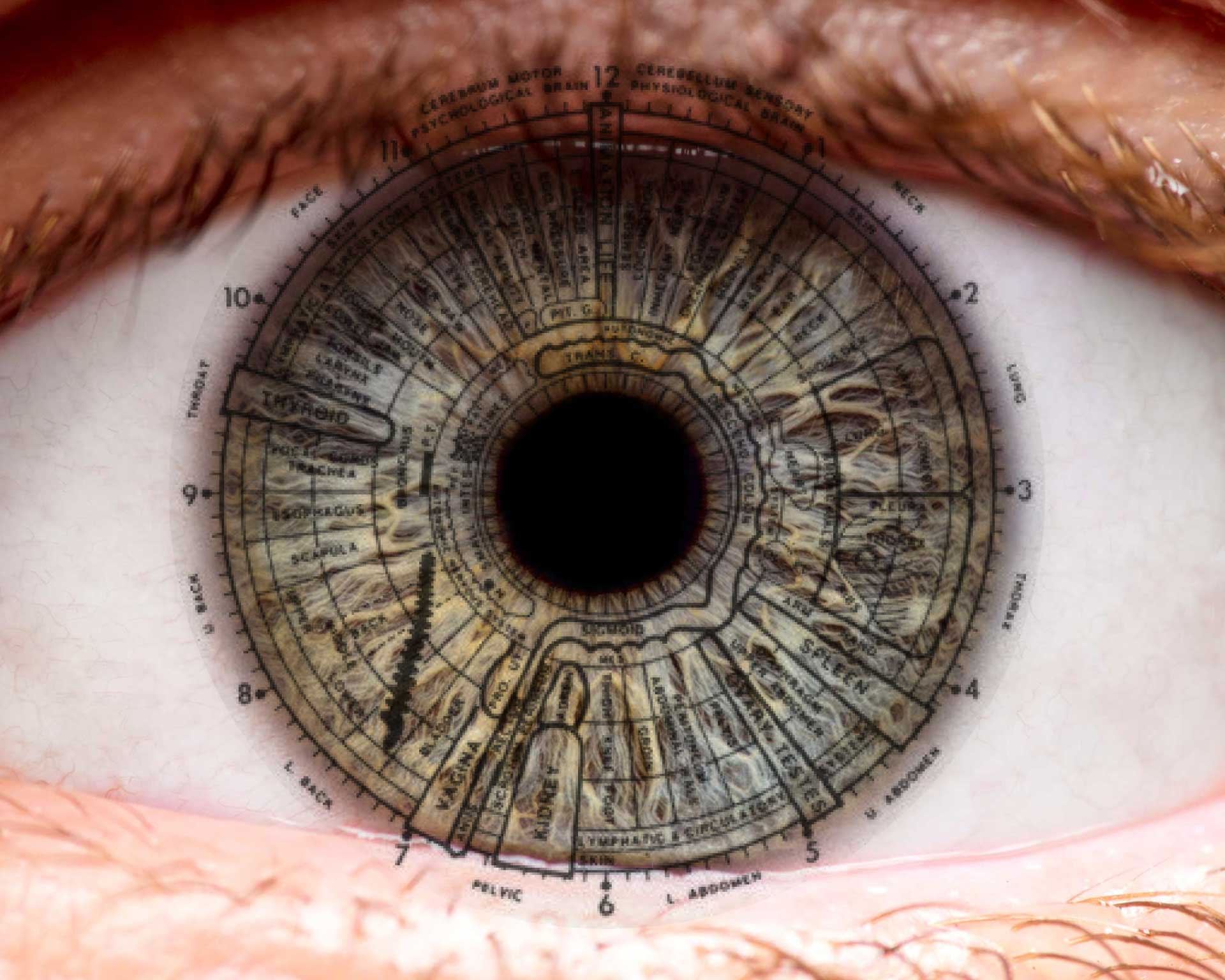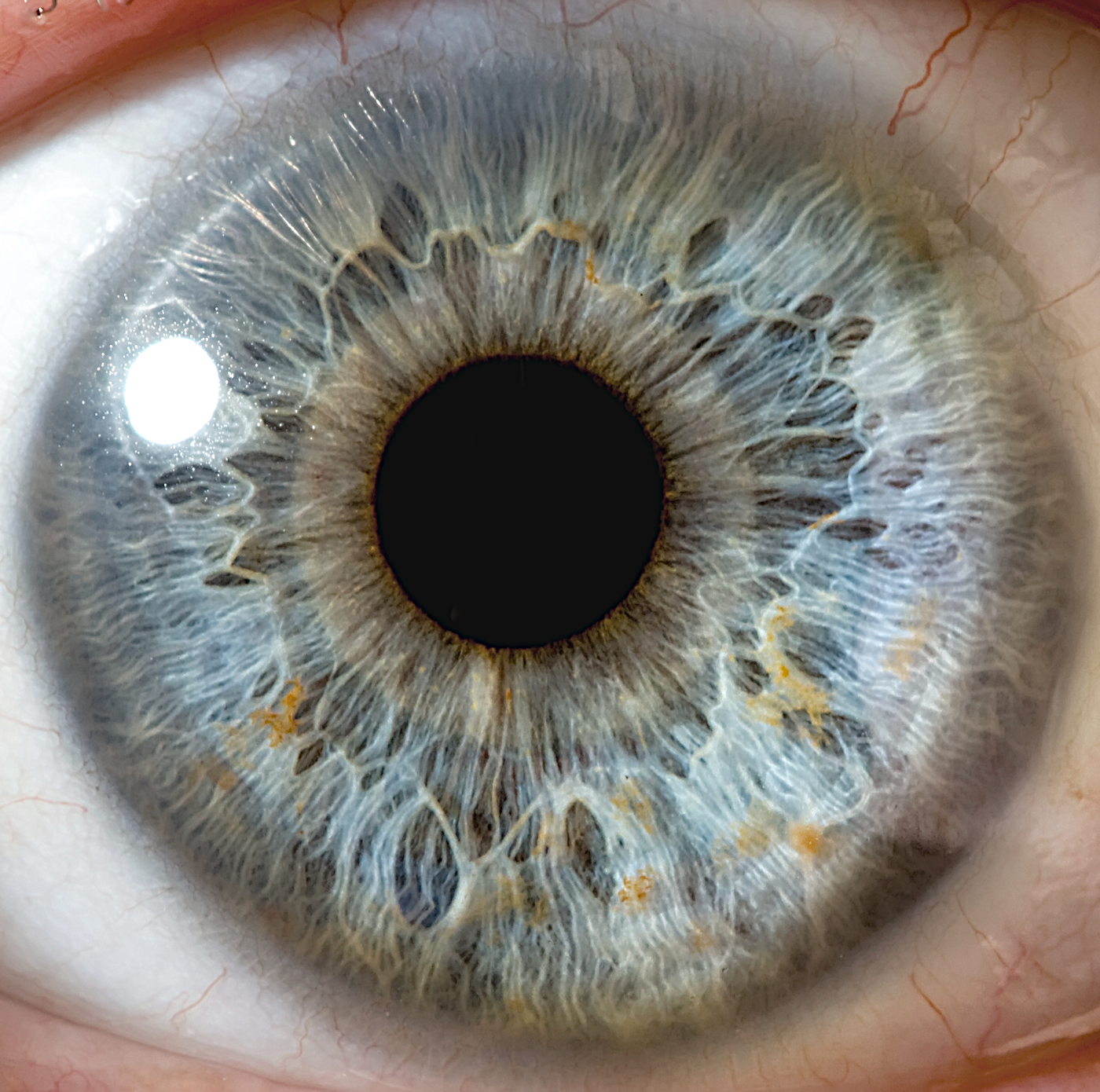Iridology
The eye truly is a window to the soul. Accurate analysis of iris structure and pigmentation provides valuable information that is difficult to find through other methods. The information provided is so valuable that iridology deserves to become a widely practiced assessment tool in both the physical and psychological health fields. There are many factors that influence our health and personality. Many of these factors are reflected in the iris. Compare the color and composition of your eye to those of your family or friends. You will notice many different patterns of iris fibers and colors. Just like your fingerprint, no two irises are exactly alike. The structure of your iris is so unique that it is now being used as security identification at ATM machines and airports. Homes of the future will use it to replace keys and alarm codes.
The Science of Iridology is based on the analysis of the most complicated structures of the whole body – the iris.

This analysis gives the health practitioner the reflex condition of the various organs and systems of the body. These markings provide a detailed picture of the areas of potential weakness including congestion or toxic accumulations and inherent challenges or talents.
The reflex relationship between the iris and the organs and systems of the body provides us with invaluable insight into the vital status of the health of the body by transmitting that information to the eye. The procedures used by modern medicine are often expensive, time-consuming and uncomfortable to the patient. Iridology provides a simple, painless, economical and non-invasive way of looking into the body. This is not to say that other forms of analysis should be excluded. Alternatively, it may be used in conjunction with any other system of analysis the health practitioner wishes to use. Iridology provides a much needed accurate and less complex method of analyzing a patient’s condition.
By the time conventional medicine discovers the existence of disease, it is often chronic in nature. The condition of the body can be monitored better in the iris of the eye than, perhaps, by any other methods of analysis. Therefore, potential and existing health issues present themselves in the iris long before they would be detected by the means of conventional medicine. Iridology gives essential insight into the development of chronic diseases in addition to the improvement of that disease or inflammation.
Iridology offers a unique perspective on the concept and practice of preventative health care. It is a non-invasive analysis that may be useful in the detection of existing conditions as well as genetic weaknesses. There are anywhere from 700,000 – 1.7 million nerves from the various parts of the body that connect to the optic nerve. Therefore, the current status of the organs and systems of the body is constantly transmitted to the iris giving us an accurate picture of their current status.

What are the benefits of iridology?
Iridology treats the whole person, instead of just the symptoms. It helps you understand your genetic vulnerabilities and reactive patterns. This gives you the information you need to maintain balance and guard against illness. Given the opportunity, the body will heal itself. Iridology simply provides an economical way to maintain optimal health.
The History of Iridology
The first recorded sources of iris analysis date back to ancient Bablyon.
In the 17th, 18th, and 19th centuries there were several researchers who studied the iris of the eye in relation to the condition of the body. The most illustrative being Ignatz Von Peczely in the early 1800’s. Von Peczely was 11 years old when caught an owl in his garden. He struggled with the bird. During the struggle the boy accidentally broke the owl’s leg. As Von Peczely and the owl glared into one another’s eyes, Von Peczely observed a black stripe appearing in the owl’s eye. The boy bandaged the owl’s leg and nursed it back to health and released the bird; but it stayed in his garden for several years afterward. During this time, he observed the appearance of white and crooked lines in the owl’s eye where the black stripe had originally appeared. The black stripe eventually became a tiny black spot surrounded by white lines and shading.
Von Peczely grew up to become a physician and never forgot the incident with the owl. He worked in the surgical ward of a college hospital. This gave him the opportunity to observe the irises of patients after accidents, and before and after their surgeries. The changes in these patient’s irises coincided with their injuries, surgery or illness. This convinced Von Peczely that there was a reflex relationship between the iris and the rest of the body. He was certain that the iris mirrored tissue changes in the various organs. He created the first chart of the iris of the eye based on his findings.

In the 1860’s, another young Swedish boy had a similar story. Nils Liljequist became ill as the consequence of a vaccination, followed by doses of quinine and iodine. He noticed the changes in colour of his formerly blue eyes, as the drug spots appeared.
In 1870, he published a paper describing his experiences, ‘Quinine and Iodine change the Colour of the Iris’, and in 1893 published ‘Om Oegendiagnosen’, which included his ‘Iris Chart’.
We should not be surprised that Liljequist and von Peczely’s ‘Iris Charts’ were very similar.
Iridology has progressed a lot since the 1800’s. Many scientists and doctors have researched iridology, revising and improving the chart. Much of the American medical research began with the work of Dr. Henry Edward Lane and his student, Dr. Henry Lindlahr. Dr. Lane carried out his surgeries and autopsies in correlation with iris markings. His book, “Iridology – The Diagnosis of the Eye” was published in 1904, in which he states ‘…thousands were examined before just one marking could be considered corroborated.’
Dr. J Jaskel Kritzer recorded a lifetime of research in his book ‘Iridagnosis’. His work encouraged Bernard Jensen, a student of Dr. Lindlahr into further research and the development of an updated Iris Chart.
Miles Anderson certified as an iridologist with Bernard Jensen. His early learning and his 30+ years of experience analyzing the irises of his clients has given him the ability to make a difference in the lives of thousands of people.
